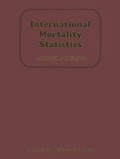Abstract
This chapter discusses the various statistical methods used in assembling and processing data. It begins with a consideration of how the population estimates have been assembled and how the numbers of deaths have been handled including the use of interpolation. A specific problem occurs where the data on numbers of deaths for the standard population are not available for the five year age group for which it is desired; a section discusses how this is dealt with.
Access this chapter
Tax calculation will be finalised at checkout
Purchases are for personal use only
Preview
Unable to display preview. Download preview PDF.
References
Alderson, M.R. (1977). An Introduction to Epidemiology. Macmillan, London.
Breslow, N.E. and Day, N.E. (1975). Indirect standardization and multiplicative models for rates with reference to the age adjustment of cancer incidence and relative frequency data. J. Chron. Dis., 28, 289–303.
Chadwick, E. (1842). Report on the sanitary condition of the labouring population of Great Britain. Reprinted Edinburgh University Press, Edinburgh, 1965.
Cox, P.R. (1976). Methods of summary and comparison, in Demography, pp 294–323, Cambridge University Press, London.
Day, N.E. (1976). “A new measure of age standardized incidence: the cumulative rate” in Cancer Incidence in Five Continents (ed. Waterhouse, J., Muir, C., Correa, P., and Powell J ). pp 443–445, International Agency for Research on Cancer, Lyon.
Farr, W. (1859). Method of comparing the local rates of mortality with the standard rate in Twentieth Annual Report of the Registrar General of Births, Deaths and Marriages in England. pp 174–176, HMSO, London.
Gaffey, W.R. (1976). A critique of the Standardized Mortality Ratio. J. Occup. Med., 18, 157–60.
Gail, M. (1978). The analysis of heterogeneity for indirect Standardized Mortality Ratios. J. Roy. Statist. Soc. A, 141, 224–34.
Gentleman, J.F. and Forbes, W.F. (1977). The identification of environmental factors in various disease processes by analysing the variation in disease-specific mortality rates. J. Chron. Dis., 30, 477–87.
Hakama, M. (1970). Age-adjustment of incidence rates in cancer epidemiology. Acta. Path. MicrobioL Scand. SuppL 213.
Johnson, C.E. (1974). Consistency of reporting of ethnic origin in the current population survey. Technical paper No. 31, US Bureau of Census, Washington.
Kalton, G. (1968). Standardization: a technique to control for extraneous variables. Applied Statist., 17, 118–36.
Kilpatrick, S.J. (1962). Occupational mortality indices. Population Studies, 16, 175–87.
Lilienfeld, D.E. and Pyne, D.A. (1979). On indices of mortality: deficiencies, validity, and alternatives. J. Chron. Dis., 32, 463–68.
Neison, F.G.P. (1844). On a method for conducting enquiries into the comparative sanitary condition of various districts, with illustrations, derived from numerous places in Great Britain at the period of the last census. J. Stat. Soc., 7, 40–68.
Osborn, J. (1975). A multiplicative model for the analysis of Vital Statistics rates. Appl. Statist., 24, 74–84.
Pascua, M. (1949). Evolution of mortality in Europe during the 20th century. Epid. Vit. Stat. Rep., 2, 64–80.
Pascua, M. (1950). Evolution of mortality in Europe during the 20th century. Epid. Vit. Stat. Rep., 3, 30–62.
World Health Organization (1975). Users’ guide to standardized computer tape transcripts. World Health Statistics Report, 28, 221–231.
Yerushalmy, J. (1951). A mortality index for use in place of the age-adjusted death rate. Amer. J. PubL Hlth., 41, 907–22.
Yule, G.U. (1934). On some points relating to Vital Statistics more especially statistics of occupational mortality. J. Roy. Statist. Soc., 97, 1–72.
Copyright information
© 1981 Michael Alderson
About this chapter
Cite this chapter
Alderson, M. (1981). Statistical method. In: International Mortality Statistics. Palgrave Macmillan, London. https://doi.org/10.1007/978-1-349-03855-8_5
Download citation
DOI: https://doi.org/10.1007/978-1-349-03855-8_5
Publisher Name: Palgrave Macmillan, London
Print ISBN: 978-1-349-03857-2
Online ISBN: 978-1-349-03855-8
eBook Packages: Palgrave Social & Cultural Studies CollectionSocial Sciences (R0)

